It is no secret that the pandemic has created chaos for retailers and manufacturers trying to balance supply and demand. A recent study “The Shipping Crisis” shows that retailers and manufacturers have found it increasingly difficult to keep store shelves filled and fulfill orders due to fluctuations in consumer demand since the virus began. The fluctuations in demand caused by the pandemic also disrupted production supply chains and severely disrupted ocean shipping schedules.
Staff shortages and congestion
Rapid changes in consumer behavior hit retailers unprepared, and when the economy stalled in the first half of 2020, retail sales fell, and inventories rose. Ocean carriers shipped more and more ships from China to the ports of Los Angeles / Long Beach, and incoming volumes have been huge. The situation was further complicated by the fact that a significant number of truck drivers were infected with Covid-19 and had to go into isolation, slowing down the movement of the containers and leaving them overcrowded. For example, since November 2020, between 20 and 40 container vessels have been continuously anchored near the ports of the Gulf of San Pedro, waiting up to 10 days to call at the port. The lack of staff only makes the situation worse.
The influence of the “Chinese factor”
Several studies suggest that the “China factor” should also be taken into account: production activity in China began to decline in the first quarter of 2020 due to the pandemic, and there were many cancellations of container vessels due to a lack of products from closed factories. The shortage of Chinese-produced raw materials, which is critical to production processes in the US, Japan and Korea, has had a negative impact on the global supply chain as a whole.
The demand of the importers
Already in the fourth quarter of 2020, Chinese production capacity reached its highest level in five years, but there is still an insufficient number of orders. US production capacity has still not recovered from pre-pandemic levels due to difficulties in attracting labor and a lack of various imported components. U.S. retailers are trying to meet demand and rebuild inventory. Ocean carriers have begun shifting more ships to alternative US ports, such as Auckland, Seattle-Tacoma, Savannah and Charleston. They have increased shipping rates in terms of spare capacity, but this has not deterred importers who are desperate to meet demand.
Historically the highest point for rail carriers
Experts estimate that the demand for more expensive air transport could increase, as transport trends have exacerbated the problem of container congestion in ports. The increase in the volume of ports in the second half of 2020 is also reflected in the volume of railways. Railway traffic exceeded the level of 2019 and reached a historically high level. Since August 2020, some railway lines have applied surcharges, sometimes as much as 100% of the base rate.
Inability to react to sharp fluctuations
The pandemic has forced the global transport sector to cope with highly volatile trade flows. Ocean carriers shall take all practicable steps to improve the speed and efficiency of cargo traffic, including the use of the capacity of all available vessels. When demand fell by around 20% to 30% in the second quarter of 2020, carriers restricted services and a number of ships were idle. However, as cargo volumes increased, carriers were unable to adapt quickly enough.
Author: Roland Peterson, logistics expert
Image: www.pexels.com



